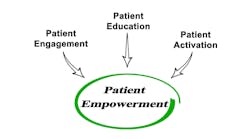"When I started here 20 months ago, there was not a lot of trust," he says, noting that the IT department had been viewed as autocratic. "They didn't solicit a lot of user input. My goal was to show we could be innovative and service-oriented without spending millions of dollars every year."
Though he didn't want to expend millions, Hamons knew he'd have to spend more than the $80,000 the hospital had put towards IT during the pervious two years. In his first year on the job, he increased that amount to $550,000 and largely revamped the hospital's infrastructure. "But we had to use a strict ROI (return-on-investment) analysis tool," he notes.
First on the list for reevaluation was SLVRMC's hospital information system — Paragon from Alpharetta, Ga.-based McKesson Provider Technologies. "That relationship had been abandoned by the hospital for a year or 18 months," he says, adding that SLVRMC was seven revisions and two years behind on Paragon upgrades. "McKesson had tried to get us to update, but there was no real direction or testing methodology in place to get things like that done."
Things had gotten so bad that Hamons was told he could replace the system if he wished, as some components of Paragon were only at 10 percent utilization. "We worked with McKesson and brought them back to the table," he says. Retraining went a long way to making the system valued again, he adds.
SLVRMC uses Paragon modules for accounts payable, accounts receivable, materials management, laboratory, radiology, order management and patient management.
In addition to taking a look at the technology, Hamons went out into the hospital and, through interviews and other forms of information gathering, determined the needs of each user group in SLVRMC. He then informed hospital management that some of those needs didn't meet up with the strategic vision SLVRMC was operating on. "We then developed a new tactical and strategic plan," he says.
While working to bring IT back in step with clinicians' needs, Hamons also turned an eye to the business office and medical records functions. After "a massive retraining effort," the hospital was able to add $6.9 million to its bottom line and improve cash flow by $800,000 per month. He also saw to the development of a SLVRMC intranet using Redmond, Wash.-based Microsoft's SharePoint technology.
Hamons then worked to improve system up-time from 65 percent to 99.2 percent by moving to a thin-client environment from Citrix, Fort Lauderdale, Fla. He put in redundant commercial-grade servers, while adding new electrical and cooling systems in the server room. The hospital also now stocks more spare items, such as hard drives, so it not as sensitive to time lost in ordering and shipping replacement parts.
But Hamons wasn't only confronted with some basic technology challenges, he also had to face a major integration project in his first week. SLVRMC was acquiring a physician services clinic with 15 providers and 50-odd employees, while also entering into a management agreement with a critical access hospital in the area. Hamons' mandate from the CEO was that the acquired clinic was to be fully integrated into the hospital's systems from day one.
With such change to the rest of the hospital's operations, it's no shock the IT department underwent a shake-up. "We turned over about 50 percent of the IT staff, but the 50 percent that stayed did what they needed to do to make the changes happen," he notes of his five-member staff.
Overall, Hamons says, running IT at a hospital is about knowing where technology fits within an organization. "The purpose of IT is to develop real business value, and that is where the innovative part comes in — by bringing the big-hospital approach to a small community setting."
Author Information:Anthony Guerra

